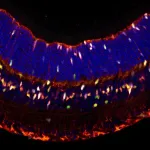(Press-News.org) Post-traumatic osteoarthritis (PTOA) is a condition that affects joints after an injury. Current treatments focus on relieving symptoms but do not prevent or stop the progression of the condition. Although emerging therapies have shown promise in preclinical studies, a major obstacle is delivering these therapies effectively into the joint, a highly dynamic environment subjected to constant mechanical stress. Researchers at Mass General Brigham have created a new hydrogel to improve drug delivery for treating PTOA. The hydrogel, which is designed to offer sustained drug release even during continuous joint movement, showed promising results in preclinical studies that mimicked the joint stress of running, highlighting the hydrogel’s potential for treating PTOA in physically active patients. Results are published in Proceedings of the National Academy of Sciences of the United States of America (PNAS).
“Disease-modifying drugs could slow, halt, or reverse PTOA, but rapid drug clearance from joints limits their effectiveness. Hydrogels can extend drug release, but can break down under mechanical stress, such as from exercise,” said lead and co-senior author Nitin Joshi, PhD, associate bioengineer in the Department of Anesthesiology, Peripoperative and Pain Medicine at Brigham and Women’s Hospital (BWH), a founding member of the Mass General Brigham healthcare system. Joshi is also an assistant professor of anesthesia at Harvard Medical School.
“We recognized these limitations and designed a hydrogel that continuously releases medication without being affected by mechanical stress” said co-senior author Jeffrey Karp, PhD, distinguished chair of anesthesiology at BWH. Karp is also a professor of anesthesia at HMS.
For the study, which was funded by the National Institutes of Health, researchers used triglycerol monostearate (TG-18), a common food additive, to create a hydrogel that rapidly repairs itself after mechanical stress. In a mouse model, they found that the hydrogel was self-healing, meaning it liquefied under mechanical stress and then instantly reformed. This self-healing property ensured long-lasting, stable and sustained release of a disease-modifying drug—even during continuous joint movement—and significantly reduced cartilage damage. Interestingly, the hydrogel also improved joint lubrication.
“Our hydrogel technology could transform the treatment of PTOA by reducing the need for frequent injections, slowing disease progression, and potentially delaying or preventing surgery,” said co-senior author Joerg Ermann, MD, an attending rheumatologist in the Division of Rheumatology, Inflammation and Immunity at BWH and assistant professor of medicine at Harvard Medical School. “This is particularly important for athletes, military personnel, and young adults recovering from joint injuries who need effective therapies that allow them to maintain active lifestyles.”
END
New flexible hydrogel could improve drug delivery for post-traumatic osteoarthritis treatment
Mass General Brigham researchers have developed a new hydrogel that did not break down under repeated joint stress and resulted in long-lasting, sustained drug release in preclinical studies
2025-03-31
ELSE PRESS RELEASES FROM THIS DATE:
Association for Molecular Pathology celebrates U.S. District Court’s decision to vacate FDA rule on laboratory-developed test procedure regulation
2025-03-31
ROCKVILLE, Md. – March 31, 2025 – The Association for Molecular Pathology, the premier global molecular diagnostic professional society, and pathologist Michael Laposata, M.D., Ph.D., today announced a favorable ruling in their lawsuit against the U.S. Food and Drug Administration over the regulation of laboratory-developed test procedures. The ruling by Judge Sean D. Jordan of the U.S. District Court for the Eastern District of Texas granted AMP’s motion for summary judgment ...
Dr. Christopher Kramer is new American College of Cardiology President
2025-03-31
Christopher M. Kramer, MD, FACC, today assumed the role of president of the American College of Cardiology, an almost 60,000-member global cardiovascular organization working to transform cardiovascular care and improve heart health for all.
“I see significant challenges and opportunities for the field of cardiology in the coming years, including workforce issues, health equity, diversity and inclusion, and AI-driven solutions, that need to be addressed to achieve ACC’s mission of transforming cardiovascular care for all,” ...
Dr. David Winchester is new Chair of ACC Board of Governors
2025-03-31
Effective today, David E. Winchester, MD, MS, FACC, will serve as chair of the American College of Cardiology Board of Governors (BOG) and secretary of the Board of Trustees. His term will run one year from 2025-2026.
Winchester will lead governors from chapters representing all 50 states, the District of Columbia, Puerto Rico, Canada, Mexico and representatives from the U.S. health services. The BOG serves as the grassroots governing body of the ACC, a leading cardiovascular organization representing over 56,000 cardiovascular care team members around the world.
“Being Chair of the Board ...
4:3 Intermittent fasting shows modestly greater weight loss than daily caloric restriction
2025-03-31
Embargoed for release until 5:00 p.m. ET on Monday 31 March 2025
Follow @Annalsofim on X, Facebook, Instagram, threads, and Linkedin
Below please find summaries of new articles that will be published in the next issue of Annals of Internal Medicine. The summaries are not intended to substitute for the full articles as a source of information. This information is under strict embargo and by taking it into possession, media representatives are committing to the terms of the embargo not only on their own behalf, but ...
Patient navigators improve colonoscopy rates after abnormal stool tests, study shows
2025-03-31
TUCSON, Arizona — A University of Arizona Health Sciences-led study found that patients are more likely to get colonoscopies following abnormal stool test results if patient navigators assist them through the process.
The paper, published in the Annals of Internal Medicine, showed that 55% of patients who were assigned to a patient navigator received follow-up colonoscopies within a year compared with 42.5% of patients who received usual care without a navigator.
“It is important for patients with abnormal stool test results to get a colonoscopy as soon as possible to prevent an increased risk of colorectal cancer and later-stage cancer detection,” ...
New warnings of a ‘Butterfly Effect’ — in reverse
2025-03-31
Contact: Bess Connolly, 203-432-1324 or elizabeth.connolly@yale.edu
New Haven, Conn. — A Yale-led study warns that global climate change may have a devastating effect on butterflies, turning their species-rich, mountain habitats from refuges into traps.
Think of it as the “butterfly effect” — the idea that something as small as the flapping of a butterfly’s wings can eventually lead to a major event such as a hurricane — in reverse.
The new study, published in the journal Nature Ecology and Evolution, ...
Scientists solve “cocktail party” mystery of bat echolocation
2025-03-31
Aya Goldshtein, Omer Mazar, and Yossi Yovel have spent many evenings standing outside bat caves. Even so, seeing thousands of bats erupting out of a cave and flapping into the night, sometimes in densities so high that they appear liquid, astounds the scientists every time. But until recently, the bat biologists were even more baffled by what they didn’t see. “The bats don’t run into each other,” says Goldshtein from the Max Planck Institute of Animal Behavior, “even in colonies of ...
USC Stem Cell mouse study identifies shared genes involved in hearing and vision regeneration
2025-03-31
The same genes could hold the key to regenerating cells in the ear and eye, according to a new mouse study from the USC Stem Cell laboratory of Ksenia Gnedeva, PhD, published in the Proceedings of the National Academy of Sciences (PNAS).
“The proliferation of progenitor cells in response to injury is a crucial step in the regeneration of sensory receptors, but this process is blocked in the mammalian inner ear and retina. By understanding the genes that enforce this block, we can advance efforts to restore hearing and vision in patients,” said Gnedeva, an assistant professor in the USC Tina and Rick Caruso Department of Otolaryngology ...
New study challenges the story of humanity’s shift from prehistoric hunting to farming
2025-03-31
A new study published in Proceedings of the National Academy of Sciences (PNAS) has turned traditional thinking on its head by highlighting the role of human interactions during the shift from hunting and gathering to farming - one of the biggest changes in human history - rather than earlier ideas that focused on environmental factors.
The transition from a hunter-gatherer foraging lifestyle, which humanity had followed for hundreds of thousands of years, to a settled farming one about 12,000 years ago has been widely discussed in popular books like Sapiens: A Brief History of Humankind by Yuval Noah Harari.
Researchers from the University of Bath, the Max Planck Institute ...
Oldest known phosphatic stromatoporoid sponge discovered in south China
2025-03-31
International scientists have uncovered the oldest known phosphatic stromatoporoid sponge, dating back approximately 480 million years to the Early Ordovician, in South China.
Stromatoporoid sponges were key reef builders during the Palaeozoic era, playing a crucial role in constructing biological frameworks—similar to the role of modern corals. They were especially important during the middle Paleozoic era (from the late Middle Ordovician to Devonian), a time marked by a major transition from microbial-dominated to skeletal-dominated reef ecosystems. Previously, stromatoporoid ...
LAST 30 PRESS RELEASES:
Making lighter work of calculating fluid and heat flow
Normalizing blood sugar can halve heart attack risk
Lowering blood sugar cuts heart attack risk in people with prediabetes
Study links genetic variants to risk of blinding eye disease in premature infants
Non-opioid ‘pain sponge’ therapy halts cartilage degeneration and relieves chronic pain
AI can pick up cultural values by mimicking how kids learn
China’s ecological redlines offer fast track to 30 x 30 global conservation goal
Invisible indoor threats: emerging household contaminants and their growing risks to human health
Adding antibody treatment to chemo boosts outcomes for children with rare cancer
Germline pathogenic variants among women without a history of breast cancer
Tanning beds triple melanoma risk, potentially causing broad DNA damage
Unique bond identified as key to viral infection speed
Indoor tanning makes youthful skin much older on a genetic level
Mouse model sheds new light on the causes and potential solutions to human GI problems linked to muscular dystrophy
The Journal of Nuclear Medicine ahead-of-print tip sheet: December 12, 2025
Smarter tools for peering into the microscopic world
Applications open for funding to conduct research in the Kinsey Institute archives
Global measure underestimates the severity of food insecurity
Child survivors of critical illness are missing out on timely follow up care
Risk-based vs annual breast cancer screening / the WISDOM randomized clinical trial
University of Toronto launches Electric Vehicle Innovation Ontario to accelerate advanced EV technologies and build Canada’s innovation advantage
Early relapse predicts poor outcomes in aggressive blood cancer
American College of Lifestyle Medicine applauds two CMS models aligned with lifestyle medicine practice and reimbursement
Clinical trial finds cannabis use not a barrier to quitting nicotine vaping
Supplemental nutrition assistance program policies and food insecurity
Switching immune cells to “night mode” could limit damage after a heart attack, study suggests
URI-based Global RIghts Project report spotlights continued troubling trends in worldwide inhumane treatment
Neutrophils are less aggressive at night, explaining why nighttime heart attacks cause less damage than daytime events
Menopausal hormone therapy may not pose breast cancer risk for women with BRCA mutations
Mobile health tool may improve quality of life for adolescent and young adult breast cancer survivors
[Press-News.org] New flexible hydrogel could improve drug delivery for post-traumatic osteoarthritis treatmentMass General Brigham researchers have developed a new hydrogel that did not break down under repeated joint stress and resulted in long-lasting, sustained drug release in preclinical studies



